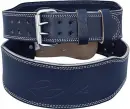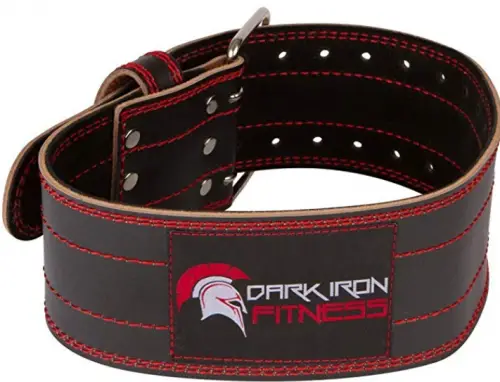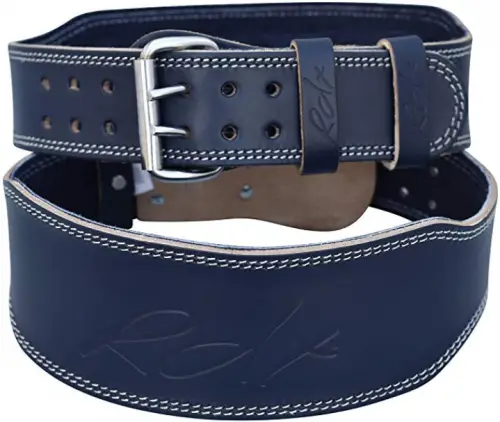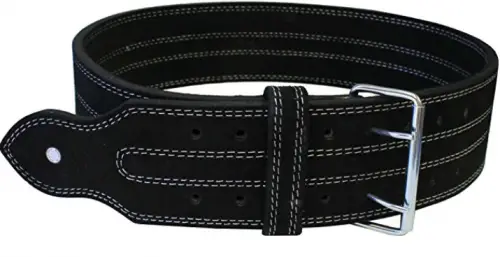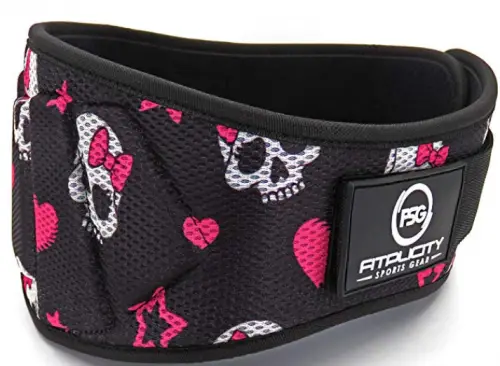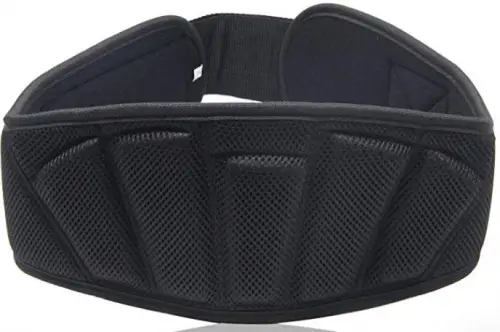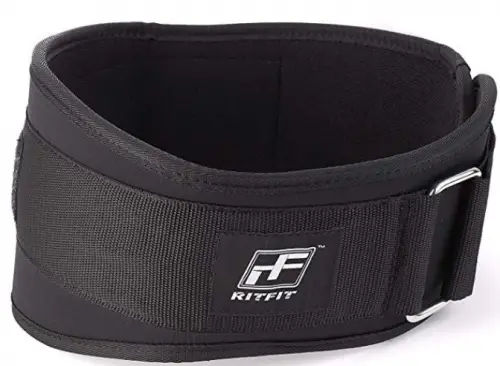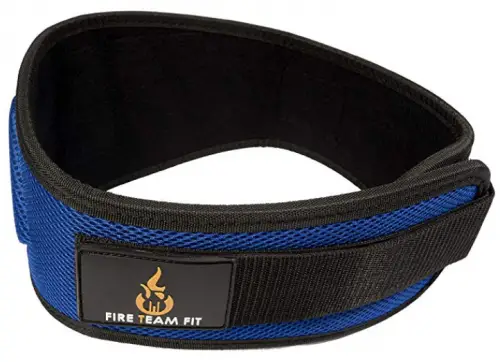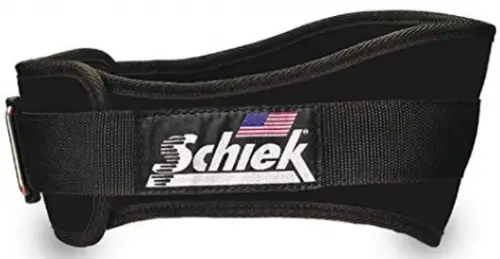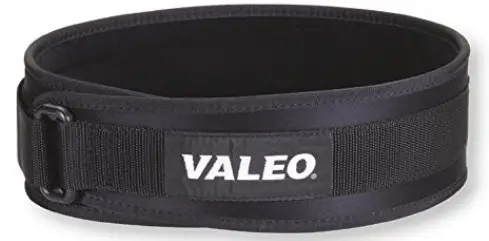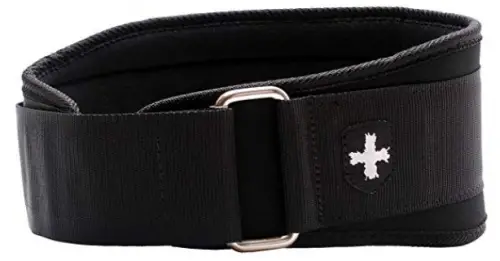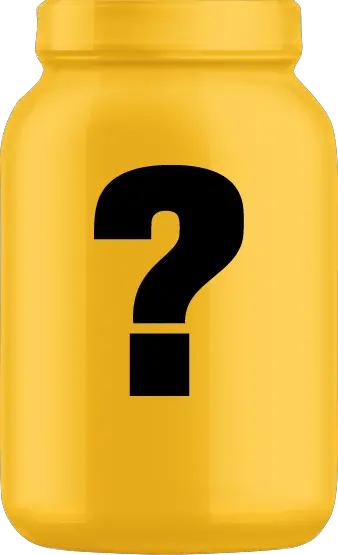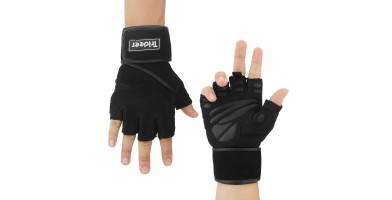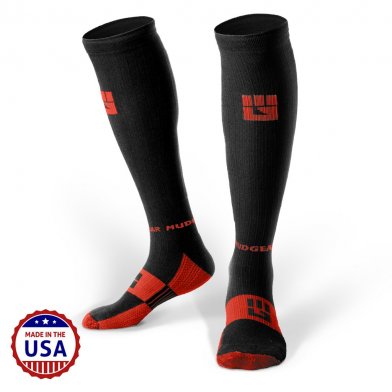Top 10 Weightlifting and Powerlifting Belts
It doesn’t matter if you’re a man or a woman; when you’re ready to get serious about lifting weights, it’s time to step up to a weightlifting belt. Not only will the right weightlifting belt or powerlifting belt allow you to lift more weight, but it will also provide your spine with additional support, to make it more stable under heavyweight. You’ll be able to squat, deadlift, and perform overhead and heavyweight power moves more safely. Having the best weight lifting belt is an essential piece of equipment for anyone serious about heavy lifting.
But the belts are often too big, bulky and don’t provide a cinched fit. Times have changed, and there is an impressive selection of belts specially designed for the female lifter, as well as the male lifter. Be sure to check out all the great information about the best weightlifting belt we have here for you!
In a Hurry? The best lifting belt after 15 hrs of research
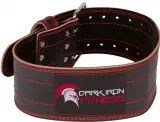
Cow Leather Construction
4 Layers Of Double Stitching
Sturdy Double Buckling System
4 Inches Of Uniform Thickness
Adjustable Non-slip Fit
10 Best Weight Lifting Belts
1. Dark Iron Fitness Genuine Leather
Cow Leather Construction
4 Layers Of Double Stitching
Sturdy Double Buckling System
4 Inches Of Uniform Thickness
Adjustable Non-slip Fit
Tough Break-In
Color Comes Off
The Genuine Leather Pro from Dark Iron Fitness for men is constructed from real, hardwearing genuine leather. This weight lifting belt has four layers of double stitching to ensure toughness and durability during strength training and weight lifting.
Read moreThis unit is four inches across its entire length, unlike most weightlifting belts that can taper down at the front; this provides you with maximum protection to your whole core as you are pushing maximum loads. The fastening system on this powerlifting belt is by way of a heavy-duty double buckling system which comes with 11 sets of holes to allow for a precision fit. Dark Iron Fitness Genuine Leather also features an adjustable non-slip fit, meaning that you will not have to contend with it slipping while you’re lifting heavyweight. It comes with a 100% replacement warranty.
2. RDX Cowhide
Reinforced Double Stitching
Sweat-wicking Properties
Buffalo Hide Exterior
Cowhide Suede Lines
Non-slip Grip
Front Not Wide Enough
The RDX Cowhide weightlifting belt for men provides four inches of back support with a genuine cowhide suede interior to protect the lumbar region from the heavy pressure of squatting.
Read moreThe reinforced double stitching used on this model provides an effective sweat-wicking system while also enhancing the durability of the product. The fastening system is by way of a double-pronged roller system, which provides a secure, easy release. The exterior of the RDX weight lifting belt is made from extremely tough wearing buffalo hide. It is four inches through the back region to provide full support to your lumbar area. As a bonus, this belt is shipped in a long box so that it won’t be folded.
3. Ader Leather
Soft Suede Inner Lining
Double Pronged Chrome Buckle
4-inch Uniform Width
Single Loop
Holes Are Too Small
Runs Large
The Ader Leather powerlifting belt for men is made of high-quality genuine leather and has a soft suede inner lining. It makes it extremely tough while also being comfortable while you wear it.
Read moreThis lifting belt is three-eighths of an inch thick and four inches wide, providing you with a high degree of support for both your lumbar region and your abdomen. The fastening system uses a double-pronged chrome roller buckle and a single loop. High-quality double stitching provides extra rigidity, while also serving as a sweat-wicking and moisture resistant measure. This third best weight lifting belt on our list is finished in a stylish black. Ader Leather Power is a high-quality belt that provides reliable protection at a competitive price.
4. Fitplicity
Specially Designed For Women
5-inch Back Support
Very Stylish Design
Velcro Adjustment Strap
Foam Core Inner
Not A Uniform Thickness
Not For Petite Women
The Fitplicity weightlifting belt is specially designed to provide support for female weightlifters. Probably the most stylish weight lifting belt ever created, the pink and black design look cool while being extremely functional.
Read moreIt provides a massive 5 inches of back support, tapering down to a 3-inch front. The Fitplicity weightlifting belt is made with an extremely light foam core; this unit has a tricot inner lining that is very comfortable on the skin while providing warmth to the muscles. The fastening system is by way of a two-inch Velcro support strap. It makes for a reliable, fast way to get this powerlifting belt on and off. Because it is so lightweight, this lifting belt is perfect for CrossFit training and female lifters. An ultra-light foam core gives added support and protection to the lower back. The Fitplicity comes with a 60-day money-back guarantee.
5. Emerge Power
Handcrafted
Lever Buckle System
Comfortable Nylon Construction
Easy On-off
Steel Tension Buckle
Stiff
On The Bulky Side
The Emerge weightlifting training powerlifting belt for men and women is the most secure nylon weightlifting belt on the market. Its large size provides maximum protection for your entire core, with an accent on the lumbar region.
Read moreThe lifting belt is sturdy enough to provide firm support for the abdomen and lower back even when you lift the heaviest of weights. It’s easily adjustable with the premium hook and loop fastening system and includes a steel tension buckle. It makes it a breeze to transition from light to heavy gym moves. The Emerge nylon belt is the best product we have found yet when it comes to supporting your abdomen and lower back, improving your stability and lifting power and preventing injuries. Emerge provide this lifting belt in a range of sizes to ensure that you get just the right fit.
6. RitFit Women's Belt
Ergonomically Designed
Low Profile Torque Ring
Reduces Spinal Flexion
Hand Washable
For Beginners
The RitFit women’s powerlifting belt provides an impressive six inches of back thickness. It is the most back support that we have yet seen in a women’s lifting belt.
Read moreThe lifting belt has been ergonomically designed to provide the best ergonomic support to the entire core area while lifting. The inner foam core of this unit provides extra comfort and protection to the lower back. Comfort is enhanced with softbound edges and tricot inner lining. The thickness of this unit tapers down by about an inch at the front, still providing plenty of support for the abs to brace against. A Velcro enclosure allows you to get just the right fit. The RitFit is hand washable.
7. Fire Team Fit
Adjustable Velcro Support System
Flexible Yet Firm
Range Of Colors
5-inch Back Support
Antimicrobial And Sweat Resistant
Front Not Wide Enough
Sizes Run Slightly Small
The Fire Team Fit weightlifting belt is a nylon belt with an adjustable Velcro support system to allow for precision adjustment. It is unlike a leather belt, which has predetermined belt holes. The Fire Team Fit ladies’ weightlifting belt has a lightweight, contoured design that looks great and is highly functional. The nylon webbing construction of the belt is breathable, antimicrobial and sweat resistant.
Read moreThis lifting belt model provides you with a rigid level of spine support while also allowing you to perform a full complement of CrossFit or plyo type moves. That’s because it is more flexible than a leather powerlifting belt. FireTeam Fit features a heavy-duty roller buckling system to provide the most secure of fits. It gives a very comfortable fit and is available in a range of colors. It is offered at an excellent price and comes with a 100% money-back guarantee. This belt is unique for such exercises as squats, deadlifts, overhead presses, and power cleans. At the same time, it is ideal for providing back support when performing CrossFit type moves.
8. Iron Game Schiek
Patented Rear Angle
Rib And Hip Contours
Wider In Front
One Way Velcro Closure
Uncomfortable For Tall People
The Schiek weightlifting belt for women provides comfortable, secure back support during powerlifting and weightlifting. It is contoured to fit the shape of your body and has a unique patented angle through the rear to naturally fit the shape of the user’s back.
Read moreIt also features patented contours in the rib and hip area to provide an even firmer, more secure fit while you are lifting heavyweights. While many leather lifting belts are not as thick in the front, Schiek weight lifting belt widens to provide extra support for the abdomen. This Velcro weight lifting belt comes with a heavy-duty stainless steel slide bar buckle to keep you strapped in while you’re under load, and the velcro provides a secure enclosure. The lifting belt feels great to wear with no itchiness while giving the right amount of intra-abdominal pressure. The downward angled design works with the natural movement patterns of the body around the waist, allowing you to perform more freely.
9. Valeo 4-Inch VLP Performance
Soft Bound Edges
Torque Ring Fastening System
Tricot Inner Lining
Low Profile
Waterproof
Slides Around Sometimes
The Valeo Performance 4-inch VLP low profile lifting belt has a 4-inch wide foam core that runs around the entire body; this provides equal support for the spine and the abdomen. The torque ring fastening system makes use of top quality Velcro, ensuring a fast, reliable securing mechanism during strength training.
Read moreThe soft-bound edges and tricot inner lining of this unit make it extremely comfortable to wear. The foam core of this lifting belt is waterproof. Because the lifting belt is lightweight and secure, it is perfect for wearing during your CrossFit WOD, where you are quickly moving from heavy Olympic weightlifting exercises to plyometric jumping and calisthenic type moves. Although not ideal for max heavy lifts, it is an excellent beginner belt for those just starting with their strength training routine.
10. Harbinger Ultra-Light
5-inch Back WIdth
Lightweight Foam Core
Tricot Lining
Steel Roller Buckle
Abrasion Resistant
Runs Small
Forms Creases
The Harbinger Flexible upright foam core weightlifting belt for men comes in four sizes, providing you with a large 5-inch wide support system for the lower back. It features a flexible, lightweight foam core to generate warmth in the lumbar muscles while still offering maximum support and guidance.
Read moreAbrasion-resistant nylon surrounds the foam. The buckling system of the Harbinger lifting belt consists of a heavy-duty steel roller buckle, which is easy to operate and provides a very secure hold. This lifting belt has a tricot lining, which is very comfortable against the skin. With 5 inches at the back and 3 in the front, you will get ample back and abdominal support with this unit. It comes with a 90-day manufacturer’s warranty.
Criteria Used for Evaluation

Use
Before we get to the belt, you have to make sure that you are performing your lifts with the proper form and technique. There are several do’s and don’ts associated with weightlifting form and powerlifting technique and it is good to learn about these techniques so that your weightlifting training is safer and more effective.
You will want to start by lifting an appropriate amount of weight. It means a weight that you are comfortable with and can conceivably lift around fifteen times. As you continue these reps, you will gain strength and can gradually begin to increase the amount of weight you are lifting. If you are a male or female weightlifter, then you have probably heard the term Valsalva maneuver. The Valsalva maneuver is simply the act of trying to exhale with both the nostrils and mouth closed. Doing this will increase the pressure in your ears and chest when you brace before you lift heavyweights. It is also considered a means of helping to equalize the pressure in your ears. During the Valsalva maneuver, there is a reduction of the filling of the right and the left side of the heart. The stroke volume, as well as blood pressure, will fall as the heart rate increases.
Now that we have that out of the way let’s talk about the actual belts. If you are a beginner lifter, you might be confused about the whole belt thing, and why you need it in the first place. First things first, you shouldn’t use a belt for every gym activity you do. Belts work wonders for lifting, but they won’t be so helpful for other exercises. You need to be able to perform the Valsalva maneuver the right way, so the belt you have must not be too wide at the front since that would prevent you from doing it. Technically, the belt acts like a wall that your abs push against.
The limited space acts together with the added force to increase the pressure applied to your spine, stabilizing it. It also makes your torso rigid and a stable foundation that can help you lift better. An ideal belt is three to four inches wide, all-around - anything slimmer than that will not work, and anything wider than that might be too much if you have a smaller frame. Also, you don’t need to wear a belt all the time. Some people argue that you shouldn’t wear a belt at all. You truly need it when you attempt to lift heavy loads. Anything that is below 90% of your one-rep max doesn’t need the help of a belt.
Also, you have to make sure that you are wearing your belt the right way. It has to be tightened as well. You might want to move the belt to a more comfortable position, like under your gut, but avoid doing this since it defeats the whole purpose of the belt. You can do a simple test to determine whether you tightened your belt too much - take a breath and hold it in and place your belt around your abdomen. Squeeze your muscles, and if your belt allows you to squeeze them with actually providing something to squeeze the muscles against, you’re on the right track!

Effectiveness
You probably already know that the fitness community is pretty much divided when it comes to the belt. Some believe that you need it, while others think that it hinders your progress. The main benefit of the belt is the increase of intra-abdominal pressure, as we already mentioned before. The weightlifting belt is quite effective at doing this and plays an important role. The pressure keeps your core rock solid while creating a safe session. You can still increase your intra-abdominal pressure by flexing your abs as you breathe, but a belt will increase that pressure significantly, giving your spine proper support.
Something that a weightlifting belt should not be used as is a back brace. However, if you are using your belt the right way, chances are that the strain your back endures will also be lowered, and you won’t feel so fatigued. Again, all of this ties back to the pressure we talked about. A high level of IAP keeps your core tight, thus reducing the strain on your lower back.
The belt can also be a good reminder to maintain proper lifting form. Maintaining proper lifting form can be easier said than done though - there are a lot of little things you should keep watch of, which is especially tough when you are lifting heavy loads. The belt will gently remind you to keep your abs flexed when you attempt the movements.
One thing the belts certainly do is allow you to lift more weight. Some people report being able to lift 10-15% more, instantly, just by wearing a belt! It will make you progress faster, making you bigger and stronger in a shorter period.
So as you can see, belts are quite effective aid. But there are still some things you must keep in mind if you do decide to wear a belt, to remain safe. If you suffer from hypertension or any other heart disease, a belt might not be such a good idea for you. Some studies have determined that wearing a weightlifting belt can cause a spike in blood pressure, most notably diastolic pressure. This spike is only temporary though, and it will be back to normal once you take the belt off. A belt can boost your confidence, and give you a sense of false security. It might be viewed as a good thing, but it can also be a drawback.
You might think that you can lift more than you can handle with the belt strapped around your gut, and you could injure yourself this way! A weightlifting belt can also limit the development of your lower back - at least that is what some people claim. It all boils down to how you use the belt. If you use it as a back brace, you will hinder the growth of the muscles of your lower back, but if you use it the right way, you will have no issues.

Durability
One more thing to worry about is the durability of your belt. Finding a good belt that fits you well can be a cumbersome task, and if you need to pay more than you’d like for it than that makes it all the more cumbersome. It is why we want our belts to last a long time - when you already tried so hard to find a good one, it might as well last a long time to save you from searching for a new one again!
There are a few things that affect the life of your belt. The material a belt is made out of plays the most crucial role. Leather belts will, of course, last the most, as leather is quite hardy, to begin with. If you take care of it the right way, and if the construction is good, you can even expect to get a decade out of it! Nylon belts won’t last as much, but they are not as heavy and are more flexible, so you might consider sacrificing durability. The clasp can also affect the life of your belt. If you bought one that has a flimsy closure, you could kiss the belt goodbye as soon as it breaks! You won’t be able to adjust the fit properly with a bad clasp, so your belt would be rendered useless. Luckily, a good belt is easy to find, and you have our guide as proof!

Fit
Your weightlifting belt needs to fit you the right way. An ill-fitting belt will not support you the right way, nor will it let you lift using proper form. It all creates a chance for you to injure yourself, which is something that you need to avoid.
First things first, you need to look at the width of your belt. For powerlifting, you need a belt that is around four inches wide, consistently. Weight lifting belts are slightly different - The back support is usually 4-inches wide, but it tapers off at the front. Some belts have extra padding in the back, but that's only for your comfort and nothing else. This width plays a significant role since powerlifting and weightlifting need different types of support. If you like to do both things, there are belts specifically designed for that as well, so you won’t need to look at two different styles.
The thickness also affects the fit. Usually, belts are 10 to 13 millimeters thick. A thicker belt will be stiffer, and this stiffness keeps your spine from bending. When you're first buying a belt, deciding which one is better can be a tough task. More support sounds like a better choice, but in reality, for a beginner, this thickness can be too much. Thicker weights are the best for people who want to lift super heavy loads. But even the huge lifters like to use the 10mm belts! You can always give the 13mm a go, and see what works best for you.
The material can also affect the fit to some degree, but we will discuss that in greater detail in the materials section. And finally, you have to know your measurements before buying the belt. You need to measure your waist correctly, at the navel. Measure your waist firmly, and be sure that the tape goes evenly around. You don’t want the belt to pinch you when you lift! That could throw you off, and you could hurt yourself. All in all, you have to figure out what works the best for you-you have to make sure that the fit is right!

Materials
Weightlifting belts are traditionally made out of leather. Today, however, many belts are made out of nylon, foam, suede, and feature many inserts made out of a huge variety of materials. But essentially the base material for every belt you can find today is either leather or nylon, and those are the two types of material we will be discussing.
The very first difference between the two is the buckling system. Leather belts have three different styles of the system: single-prong, double-prong, some are even triple-pronged, and levers. The ends of the belt will have holes, just like your regular leather belts do. The buckles are usually made out of stainless steel, to make the belts even more durable. The buckles, prongs, and levers are strong and are made to avoid any bending while you lift. On the other hand, nylon belts also have steel buckles, but only on the fastening section on the belt. The strap that does the actual tightening will be nylon or cloth, and it will be more adjustable than the leather buckling system.
The construction of the belts is also different. Leather belts will be thicker than nylon belts. It means that they will make your torso more rigid and will give your spine more support. Leather belts are thicker because multiple layers of leather are constructed together and then enclosed with either single or double stitching. The thickness and stitching play a significant role in the belt's durability as well. Nylon belts are much thinner than leather belts, and the various stitching patterns depend on the style of the belt.
Leather belts are better for you if you lift the serious weight. It is because they give you the most stability, providing you with the chance to lift your max every time. Nylon belts are better if you are into CrossFit, functional fitness, or if you are a recreational lifter. They are lighter, not so rigid, and quite versatile, which also makes them great for beginners. So your perfect belt material is the one that caters to your needs!
Expert Interviews & Opinions
There are many different styles of the best weightlifting belts that you can choose from. It can be a little bit confusing when you try to figure out which one you need, so we will describe the four most common types and what they are used for. First, you’ve got the power belt. The name itself should tell you what the belt is for. This style is by far the most popular - it’s four inches wide throughout, and is the best for powerlifting thanks to all of that surface area. Training belts are either four or six inches wide in the back, but they taper down to 2.5-inches at the front. This belt style is great when you don’t need to lift heavy weights, like for CrossFit or Bodybuilding. Lever belts are quite similar to power belts, the only difference is that you can tighten it up more. And Bench/Oly belts are used for, you guessed it, benching!
Other Factors to Consider

Bottom Line
Weightlifting belts are quite a useful tool If you are serious about your lifting, you should utilize the best powerlifting belt found on our list. They will help you lift better, lift more, and will keep you safe from injuries. They promote proper form and keep your spine in check. We hope our guide has helped you choose your new partner, and that you will have a good time using it!
Frequently Asked Questions
q: What does a weight lifting belt do?
Said, the purpose of your belt is to keep you safe from hurting yourself. First things first, it stabilizes your spine and reduces the strain. The belts also create better body biomechanics, increasing the flexion at the knees and hips. It means that the belt forces you to lift using the strength of your legs, instead of your back, which is what you want to do when lifting. And the most important thing, belts increase your strength, making your muscles grow faster and bigger!
q: Is using a lifting belt considered cheating?
It is a concern for many people who lift professionally, but almost every country in the world does not consider wearing a belt cheating. One might think that wearing a belt is cheating since it does allow you to lift a bit more than you originally could. But you are protecting yourself from harm, and no one will deny you that!
q: Where do I put my weight lifting belt?
Since the only measurement you need to consider when buying a belt is your waist, that should tell you a little bit about where your belt needs to sit. It goes around your waist, right on top of your navel. It needs to sit on top of your abdominal muscles - anything lower than that will not help you lift better, and it might even hinder your session.
q: When should I wear my weight lifting belt?
You might feel like you need to wear your belt through the whole duration of your lifting session. It is not true, and you should only use it when you attempt to lift 90% of your max, and nothing less. When you use a belt to lift a smaller amount of weight, you might not get as strong as you would when not wearing a belt. By lifting smaller weights without a belt, you develop your muscles more, which can help you remain safe for a bigger lift. You need to be protected when you get to the massive guns, and you shouldn’t attempt this without a belt in the first place!
q: How do I wash my weight lifting belt?
One thing that you will certainly be doing when lifting is sweat. It is a natural process, as it helps keep our bodies cool. But the sweat will get into your belt, and as time goes by, it is going to smell. No one likes to smell bad, and besides that, bacteria and fungus could be growing there too, so washing your belt is quite essential. If the belt is suede or leather, you don’t need to wash it - all you need is some chalk, and that will keep it clean.
You can maintain the leather as you would regularly, and you can brush out the suede as well. Oil can help keep sweat from going into the deeper layers of the leather belts so that you could apply a coating 2-3 times a week. Nylon belts are different, since they are machine-washable, and you can throw it in a machine when you feel like it’s dirty! But always make sure that the weightlifting belt is machine-washable. Otherwise, you risk ruining it.













